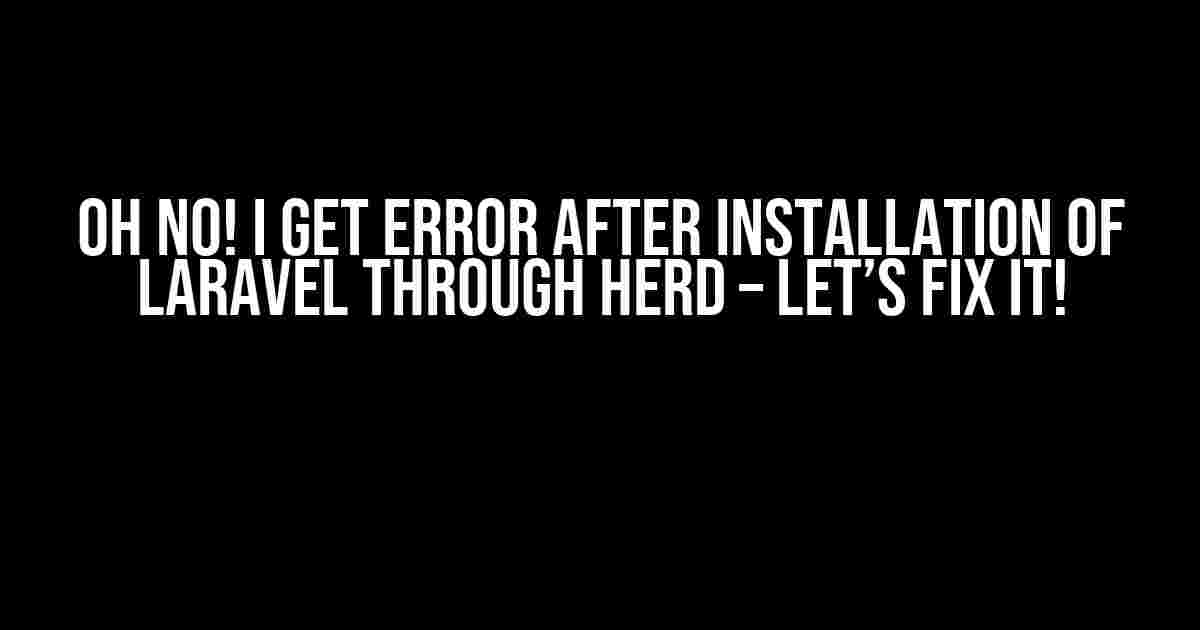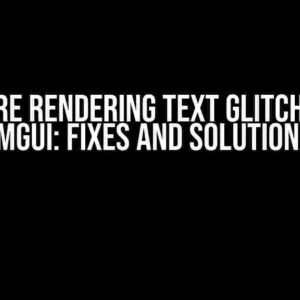Congratulations on installing Laravel through HERD! However, if you’re reading this, chances are you’re facing some pesky errors after installation. Don’t worry, we’ve got you covered. In this comprehensive guide, we’ll walk you through the most common errors and provide step-by-step solutions to get your Laravel project up and running in no time.
- Before We Dive In…
- Error 1: “Symfony\Component\Debug\Exception\FatalErrorException” – Vendor Folder Issues
- Error 2: ” McDn\Razor\RazorRuntimeException” – Razor Package Issues
- Error 3: “Fatal error: Uncaught Error: Call to undefined function …” – PHP Extension Issues
- Error 4: “Whoops, looks like something went wrong.” – Environment Variables Issues
- Error 5: “Failed to clear caches” – Cache and Storage Issues
- Error 6: “Class ‘Foo\Bar’ not found” – Autoload Issues
- Error 7: “SQLSTATE[HY000] [2002] No such file or directory” – Database Connection Issues
- Error 8: “Failed to load resource: the server responded with a status of 404 (Not Found)” – File System Issues
- Error 9: “Whoops, something went wrong…” – Unknown Errors
Before We Dive In…
Make sure you’ve followed the official Laravel installation guide through HERD (Homestead, Easy, Radical, Dude!) and have a basic understanding of command-line interfaces and terminal commands. If you’re new to Laravel or HERD, take a moment to review the official documentation:
Error 1: “Symfony\Component\Debug\Exception\FatalErrorException” – Vendor Folder Issues
If you’re encountering the “Symfony\Component\Debug\Exception\FatalErrorException” error, it’s likely due to issues with the vendor folder. This error usually occurs when the vendor folder is not properly installed or updated.
Solution:
Follow these steps to resolve the issue:
- Open your terminal and navigate to the root of your Laravel project:
cd ~/projects/my-laravel-project- Delete the existing vendor folder:
rm -rf vendor- Run the following command to install the dependencies:
composer installThis command will reinstall the vendor folder and its dependencies. Be patient, as this process might take some time.
Error 2: ” McDn\Razor\RazorRuntimeException” – Razor Package Issues
If you’re facing the “McDn\Razor\RazorRuntimeException” error, it’s likely due to issues with the Razor package.
Solution:
Follow these steps to resolve the issue:
- Open your terminal and navigate to the root of your Laravel project:
cd ~/projects/my-laravel-project- Update the Razor package using the following command:
composer update razorThis command will update the Razor package to the latest version, resolving any potential issues.
Error 3: “Fatal error: Uncaught Error: Call to undefined function …” – PHP Extension Issues
If you’re encountering a “Fatal error: Uncaught Error: Call to undefined function …” error, it’s likely due to missing or outdated PHP extensions.
Solution:
Follow these steps to resolve the issue:
- Check the Laravel documentation to ensure you have all the required PHP extensions installed:
- Install any missing PHP extensions using the following command:
sudo apt-get install php7.4-xmlReplace “php7.4-xml” with the extension you’re missing (e.g., “php7.4-mbstring”, “php7.4-curl”, etc.).
Error 4: “Whoops, looks like something went wrong.” – Environment Variables Issues
If you’re facing the dreaded “Whoops, looks like something went wrong.” error, it’s likely due to issues with environment variables.
Solution:
Follow these steps to resolve the issue:
- Open your terminal and navigate to the root of your Laravel project:
cd ~/projects/my-laravel-project- Run the following command to copy the .env.example file to .env:
cp .env.example .envThis command will create a new .env file, which is essential for environment variables.
- Update the .env file with your environment-specific settings:
APP_NAME=My Laravel App
APP_ENV=local
APP_KEY=base64:YOUR_APP_KEY
Replace “YOUR_APP_KEY” with a randomly generated key (you can use the following command to generate one):
php artisan key:generateError 5: “Failed to clear caches” – Cache and Storage Issues
If you’re encountering a “Failed to clear caches” error, it’s likely due to issues with cache and storage.
Solution:
Follow these steps to resolve the issue:
- Open your terminal and navigate to the root of your Laravel project:
cd ~/projects/my-laravel-project- Run the following command to clear the cache:
php artisan cache:clear- Run the following command to clear the storage:
php artisan storage:linkThis command will create a symbolic link between the storage and public folders, resolving any storage-related issues.
Error 6: “Class ‘Foo\Bar’ not found” – Autoload Issues
If you’re facing a “Class ‘Foo\Bar’ not found” error, it’s likely due to issues with autoload.
Solution:
Follow these steps to resolve the issue:
- Open your terminal and navigate to the root of your Laravel project:
cd ~/projects/my-laravel-project- Run the following command to dump the autoload files:
composer dump-autoloadThis command will regenerate the autoload files, resolving any class loading issues.
Error 7: “SQLSTATE[HY000] [2002] No such file or directory” – Database Connection Issues
If you’re encountering a “SQLSTATE[HY000] [2002] No such file or directory” error, it’s likely due to issues with database connections.
Solution:
Follow these steps to resolve the issue:
- Open your terminal and navigate to the root of your Laravel project:
cd ~/projects/my-laravel-project- Update the .env file with your database credentials:
DB_CONNECTION=mysql
DB_HOST=127.0.0.1
DB_PORT=3306
DB_DATABASE=mydatabase
DB_USERNAME=myuser
DB_PASSWORD=mypassword
Replace the placeholders with your actual database credentials.
- Run the following command to migrate the database:
php artisan migrateThis command will create the necessary tables in your database, resolving any database connection issues.
Error 8: “Failed to load resource: the server responded with a status of 404 (Not Found)” – File System Issues
If you’re encountering a “Failed to load resource: the server responded with a status of 404 (Not Found)” error, it’s likely due to issues with the file system.
Solution:
Follow these steps to resolve the issue:
- Open your terminal and navigate to the root of your Laravel project:
cd ~/projects/my-laravel-project- Run the following command to link the storage:
php artisan storage:linkThis command will create a symbolic link between the storage and public folders, resolving any file system-related issues.
Error 9: “Whoops, something went wrong…” – Unknown Errors
If you’re facing an unknown error, don’t worry! Laravel provides a built-in debug mode to help you identify the issue.
Solution:
Follow these steps to enableHere are the 5 Questions and Answers about “I get error after installation of Laravel through HERD” in HTML format:
Frequently Asked Question
Uh-oh! Got an error after installing Laravel through HERD? Don’t worry, we’ve got you covered! Check out these frequently asked questions to troubleshoot the issue.
Q1: Why do I get a “composer.json” file not found error after installation?
A1: Make sure you’ve navigated to the correct directory where you installed Laravel using HERD. Run the command `cd project-name` (replace “project-name” with your actual project name) and then try running `composer install` again.
Q2: What’s with the ” permission denied” error I get when running Laravel commands?
A2: It’s a permission issue! Run the command `chmod -R 755 storage` and then `chmod -R 755 bootstrap/cache` to fix the permission issues. You can also try running the command with sudo, like `sudo php artisan storage:link`.
Q3: Why do I get a “Class ‘Illuminate\Foundation\Application’ not found” error?
A3: This error usually occurs when Laravel’s autoloader can’t find the required files. Run the command `composer dump-autoload` to recreate the autoloader files. If that doesn’t work, try deleting the `vendor` directory and running `composer install` again.



